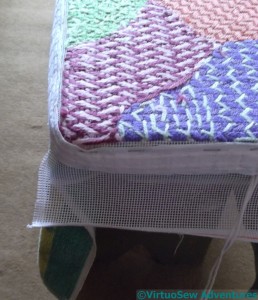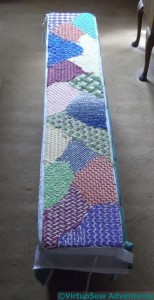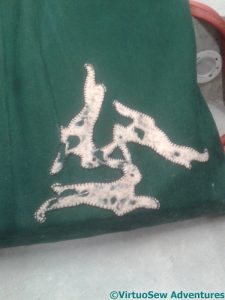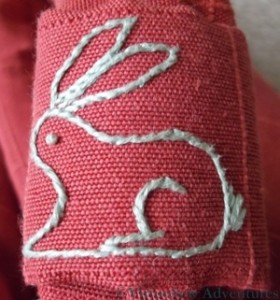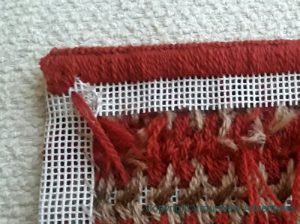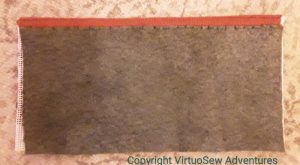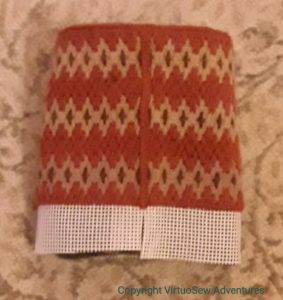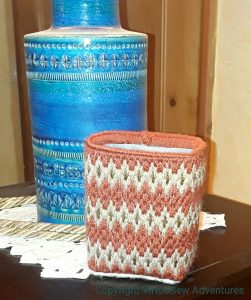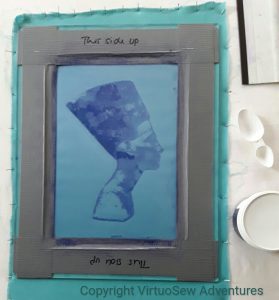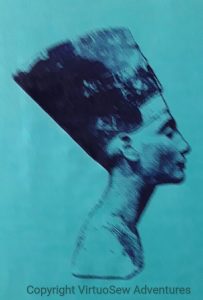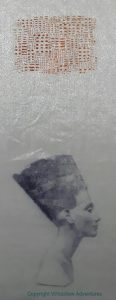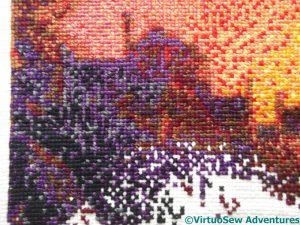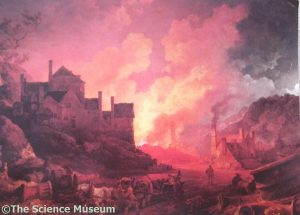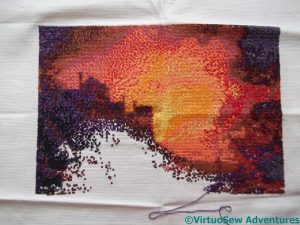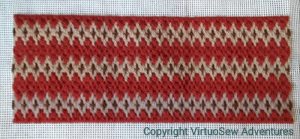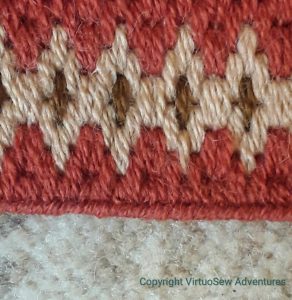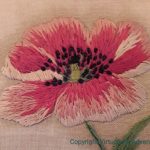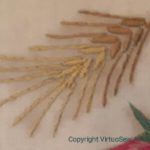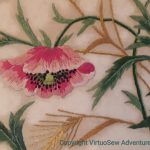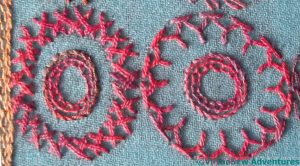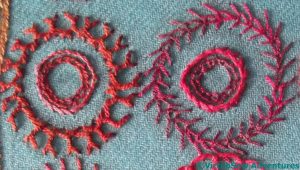About Rachel
View all posts by Rachel
The Head of Nefertiti, Embellished with Silk and Gold
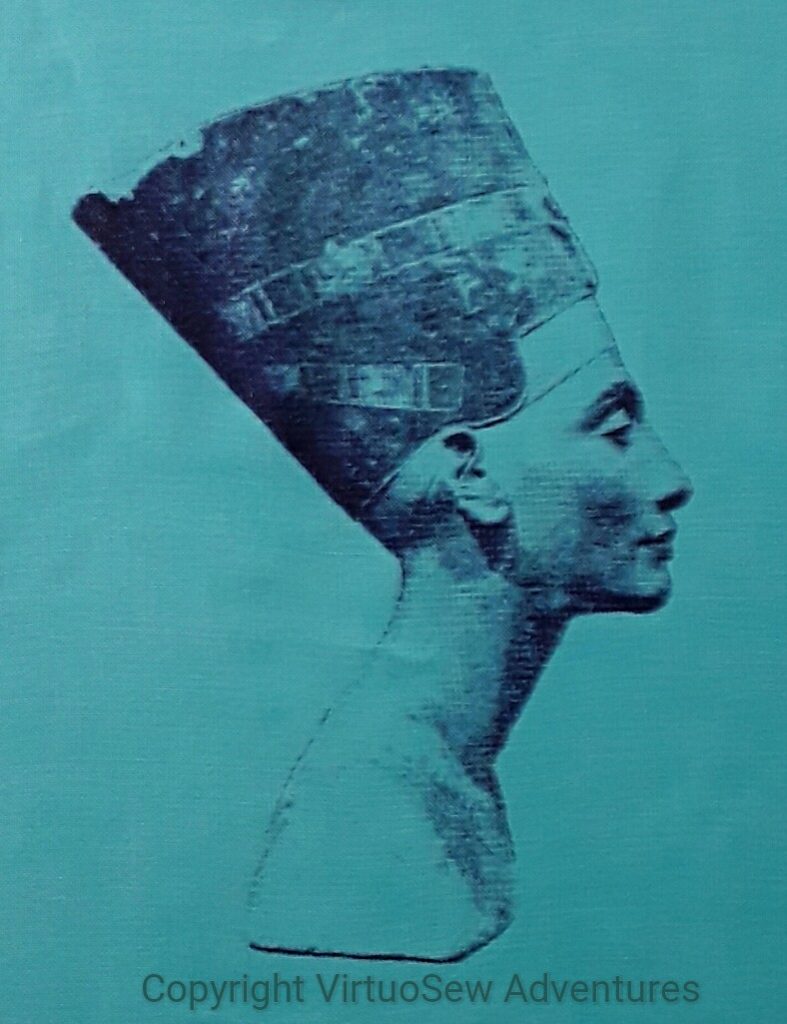
Screenprint of the Head of Nefertiti
This is much the best print I’ve managed of Nefertiti, pressure, speed and amount of ink all working nicely, and very few really dark sections. What I want to do now is to highlight the coloured elements of the crown she wears – unique to her, apparently, no-one else in ancient Egypt has ever been depicted wearing it. I’ve got some gorgeous silk threads from Mulberry Silks which should do the job perfectly, but first they need a skeleton of gold. I had a lovely rummage in among the assorted wonders I’ve received from Thistle Threads (they have their own special box, of course), and after staring critically at the linen fabric, picked out the Special Tambour, and made a start.
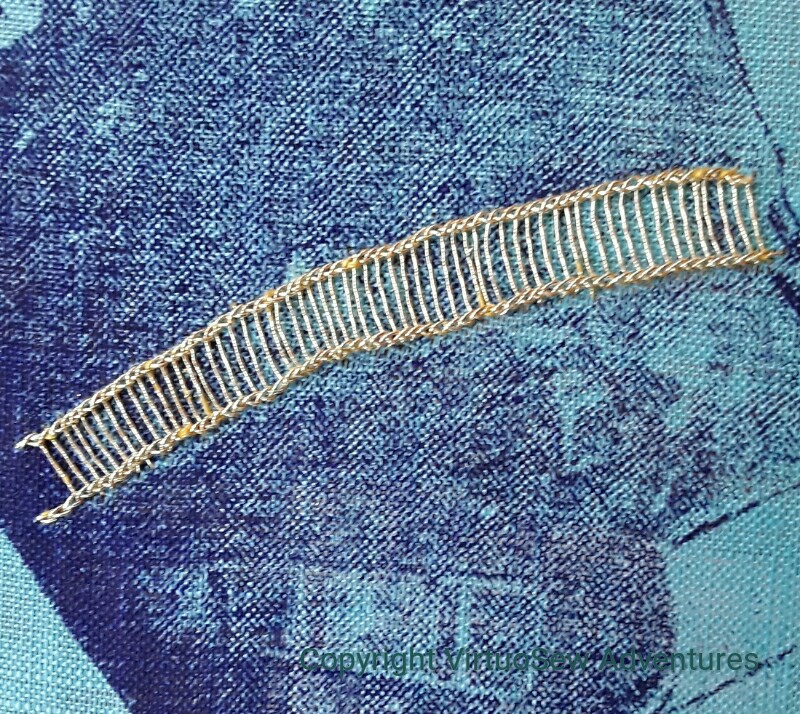 My idea is to create a framework of Ladder Stitch, and then add colour – as in the Tudor Rose project – using silk threads. Long term readers may recall that during the Tudor and Stuart Goldwork Masterclass, I had some trouble with Ladder stitch, so although I was fairly sure the idea would work, I sat down with some trepidation.
My idea is to create a framework of Ladder Stitch, and then add colour – as in the Tudor Rose project – using silk threads. Long term readers may recall that during the Tudor and Stuart Goldwork Masterclass, I had some trouble with Ladder stitch, so although I was fairly sure the idea would work, I sat down with some trepidation.
To be very pleasantly surprised. Something has happened in the intervening few years, and my ladder stitch wasn’t as trying as I expected, and moved fairly swiftly, too. I may yet decide to redo the stitches, because I re-tightened the fabric in the frame about halfway across, but that will depend upon how much better the second section looks when I have done it.
That’s a good start to a new project, isn’t it!
Three Rabbits – or are they Hares?
Rummaging around as I try to reorganise the house, I’ve rediscovered a bag I made some time ago.
The Three Rabbits (or Hares) design is an ancient one, found all along the Silk Route and in many different cultures. I’ve seen it in textiles and ceramics, carved as mere outlines, polychrome with a wealth of fabulous detail. I’ve also seen variants with animals other than hares, and even variants with more animals in the circuit.
I think I first encountered it when I first met David Singmaster, the mathematician and metagrobologist – it’s one of his many interests, and he has a drawstring bag decorated with the design that he takes everywhere, stocked with mathematical puzzles and games to entertain anyone who comes near. I saw it recently when David and his wife were at a conference my husband and I attended, and his wife remembered that her mother had had to remind her of how to do the French Knots for the eyes. I took delight in noting the puzzled brows that ensued whenever David took anything out of the bag!
My version is one of the simplest, I suspect. I designed a very simple circuit of hares (or rabbits!), and embroidered it using chain stitch on a russet coloured furnishing fabric. The bag is padded with wadding and lined with the same fabric.
Finally I designed a small buckle-type ornament made of a strip of fabric embroidered with a very definite bunny embroidered in stem stitch, and put one on each end of the strap.
I’m intending to do a much more complicated version one of these days, maybe with a mille-fleurs background like the tapestries in the Musée de Cluny.
Watch this space, as they say!
Experiments for The Head of Nefertiti
You may recall that the final “Dreams of Amarna” pair of panels is intended to include the heads of Akhenaten and Nefertiti, screenprinted onto gauze, and floating over the top as free-hanging veils.
I decided to have a small screen done of Nefertiti, in order to practice the technique and experiment with the different types of gauze.
The screen duly arrived, and I did about six prints, all of which were dreadful. I put the screen away in disgust and decided to try another time.
This print shows some of the problems. I pressed too hard, obscuring some of the detail and caking the fabric – in this case a linen, because I have a plan to add silk and gold embroidered highlights. It would be impossible to get a needle through, and if I did, a metallic thread would be stripped in short order.
There’s clearly a trick to it – a combination of pressure (not too much), amount of ink (enough!) and angle of the squeegee (just right).
These two prints on gauze give me some hope. The orangey-terracotta is the small, blocky screen I bought to test out the idea first of all. I’ll embroider something over the top of this, just to see how it works.
And the head of Nefertiti is rather better, too. Next time I get out my Dreams of Amarna pieces to stare at them and play with layouts, I will be able to hang the gauze in front and play with distance and placement.
I’m beginning to think that it isn’t outside the bounds of possibility that I might finish the Dreams of Amarna one of these days, and even be pleased with it!
Coalbrookdale in Cross Stitch
Many years ago I used to design counted cross stitch kits, and did some for the Ironbridge Gorge Museum. I did think of turning a certain very famous picture into a kit, but since we never finished the test stitch, it is just as well they decided not to go with it.
This is something else we’ve found in a fit of tidying up, and thought,”hmm, we should finish that – it will look good!”
It was done in the early days of computer-aided cross stitch design. I scanned a postcard of “Coalbrookdale By Night”, in the somewhat apocalyptic vision of Philip James de Loutherberg, and then spent some time tweaking the number of colours the computer used to render the design as a cross stitch piece. One of the problems with this form of computer design was that, no matter how much human intervention was involved, the design tended to end up being a bit spotty.
You can see that spotty effect in the detail picture above.
The human intervention did at least result in the removal of the entirely superfluous lime green stitches that the computer package used to scatter across every design it was involved in. I never did understand why that happened, but the first change I always had to make was to change the lime green into something more suitable.
What I have to do now is think of something useful to turn it into when it’s finished….
17 UFOs in 2017
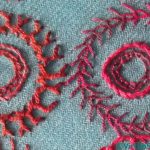
Still More Circles
Meredithe (Pomegranate and Chintz) and Anne (Frayed At The Edge) are running a challenge for the year – 17 UFOs in 2017. The idea is not necessarily to finish, but to make substantial progress, on 17 UFOs.
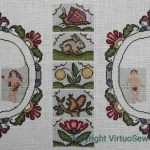
Now, I’m not sure I have that many UFOs, and I have many new projects I want to work on (more on those soon), but I do have a good few that are stalled, or that I’m not sure whether I’ve finished or not, so although I’m not going to join in regularly, I will try to use the impetus of the challenge to remind myself to assess progress.
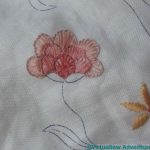
Blanket Stitch Fans
1 Eve in the Garden of Eden – I really want to finish this so I can sign up for the Stumpwork Lion!
2 Nefertiti Shawl – well, clearly, I want to be able to wear this!
3 Queen Anne style teacloth – this is a travelling project, so it depends on where I go and whether I have light or time to work on it.
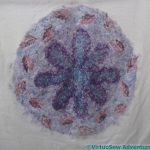
From The Back
4 The Modern Stitch-Off – I’m not sure whether this is finished or not, so if I can at least decide that by the end of the year, I’ll be pleased.
5 The Christmas Angel – I was going to work on the Christmas Angel last year between Christmas and Epiphany, and never set a stitch on it.
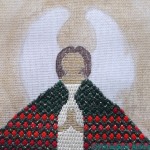
Shoulder Cape
6 The Faience Necklace – this has been a real trial to me, as I can’t bring the design into focus. I’ve got some lovely silk thread so maybe that will help me to get started.
7 The Swan – I got the first layer of Laid and Couched work done, and have had trouble working out the detail layer…
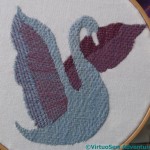
Swan – First Layer
8 The Unicorn – again, first layer done, details escaping me.
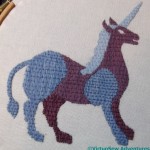
Unicorn – the first layer
I have a lot of other things I want to do, which are barely begun, never mind finished, and as I have said, in the case of several of these projects it is not a matter of simply stitching, so much as deciding what to stitch, and then stitching it.
My real target for the year with these eight is to have finished the Nefertiti Shawl and Eve in the Garden of Eden. Anything else is a bonus!
Poppies And Wheat, Cleaned and Conserved
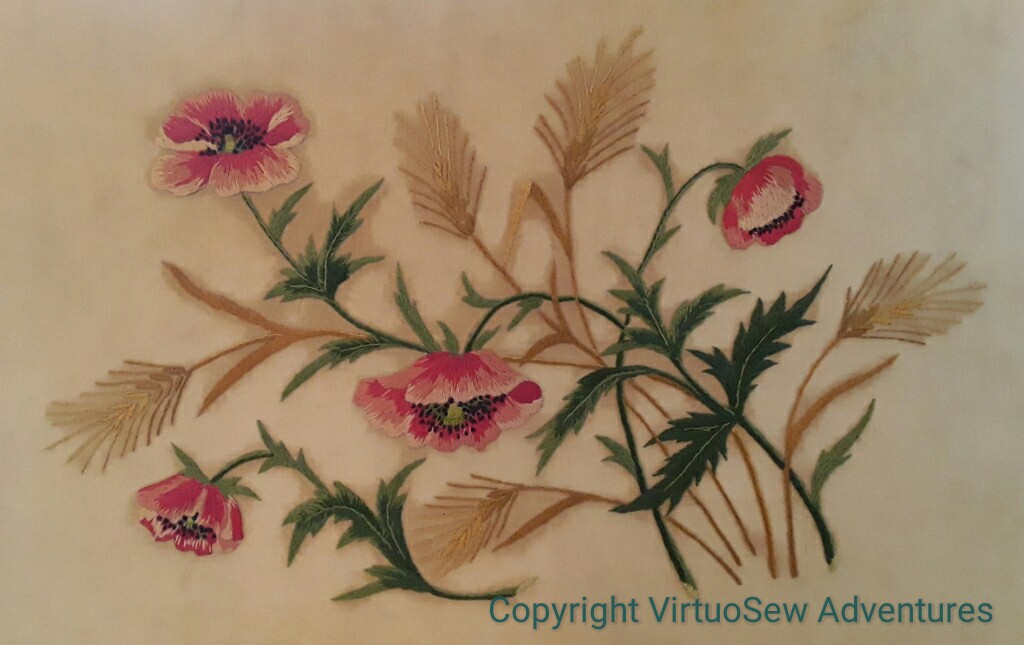
Some of you may recall that some time ago, my mother and I were planning to reframe one of my Grandmama’s embroideries, and discovered to our horror that it had been glued to a backing board made of strawboard.
In due course, we found a textile restorer, not too far away, and I took it to her. And now we have it back again. In the course of the work, it was discovered that two different sorts of glue had been used. One of them was unstuck fairly easily, but a particularly acidic glue had been used on the back of the embroidery itself – almost as if the framer did not believe the work had been finished off properly. Which it had – apparently it was very difficult to find some threads to take out to test for colourfastness!
- Poppy – Brighter and Lighter
- Wheatear – Brighter and Lighter
- Further Detail – Brighter and Lighter
The fabric and thread are both much brighter than they were, but the very acidic glue that was used is the reason for the bloom of staining around the embroidery. It’s much reduced, but unfortunately it wasn’t possible to remove it entirely.
So, Gentle Reader – be careful with glues and boards. Avoid if you can, use neutral-pH as far as you can, or someone in the future will be muttering imprecations in your direction!
The Red Panel on the Nefertiti Shawl – Part Three
Third installment..
Remember, the two inner circles are always in the same stitches – Open Chain Stitch, and Stem Stitch.
The two outer circles in this case are in Herringbone Stitch, and Half-Chevron Stitch. I’m a little disappointed that neither the counterchanges of colour nor the counterchanges of thread seem to show in this photo. I assure you, they were there when I worked it!
The first of these is Breton Stitch, which is a little like Herringbone stitch with added twist. I’m sure I could have done it with the twist towards the outside, but I think like this, it will balance some of the other circles which have a strong edge.
The second is Wheatear Stitch, which I have found myself turning to every now and again, although maybe not often enough. It produces a spiky but continuous line, so while it has definite uses, it is also one which doesn’t work in all contexts. That said, I enjoyed working it, so maybe I will be able to tweak either the context or the stitch, so as to use it more…!
This pashmina is going to be quite the stitch sampler, isn’t it!

